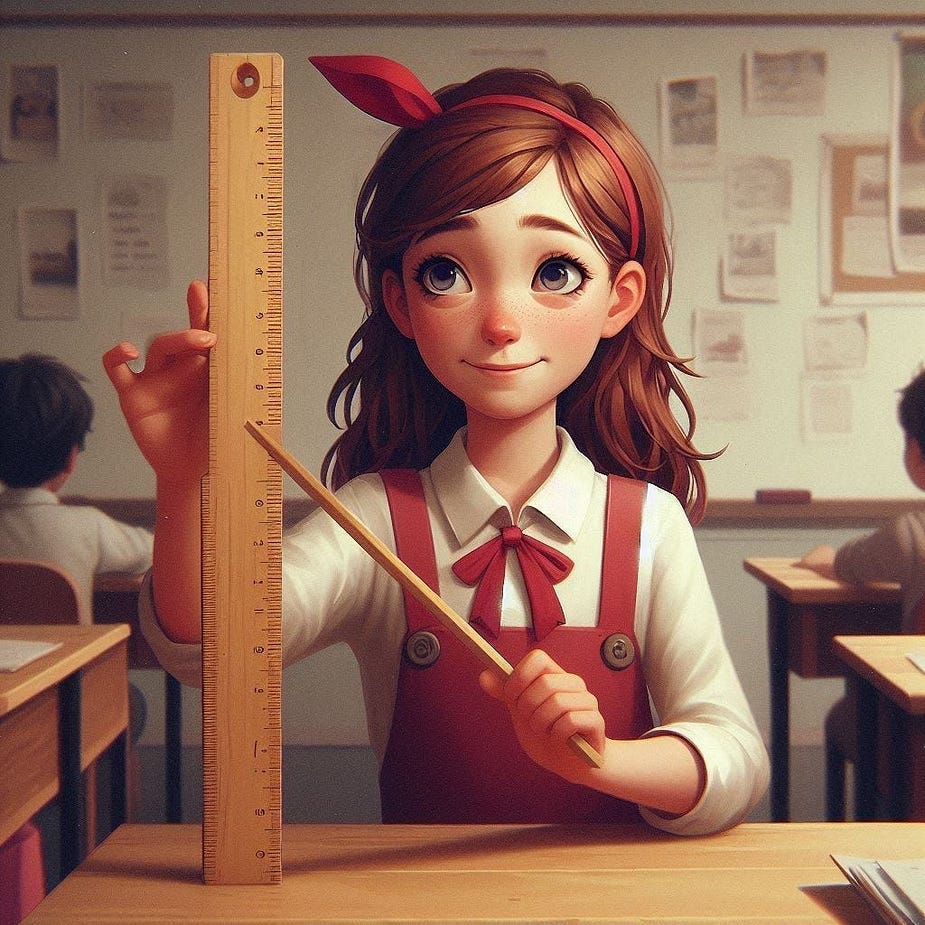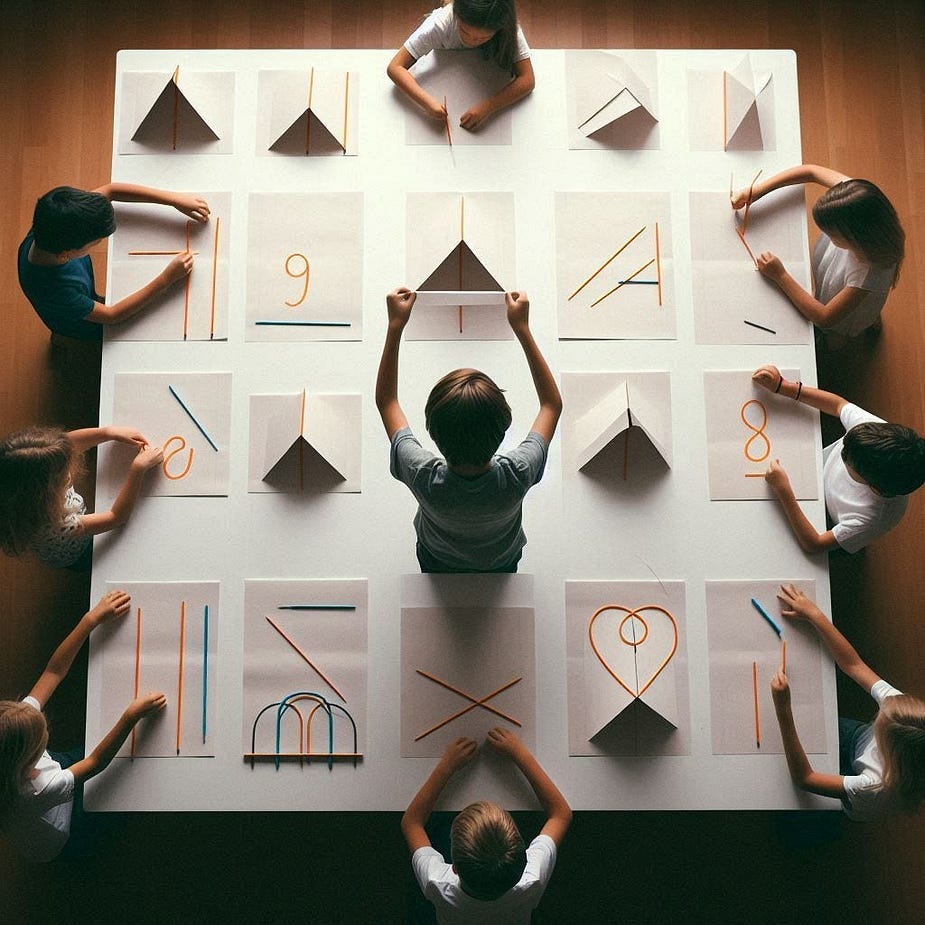Zen and Math for First Graders: Discovering Infinity
I noticed how numbers reveal the same paradoxes as Zen koans

I’ve always wondered how to explain infinity to first-grade children. I don’t have a class, and I’m not a teacher, yet this idea fascinates me: taking an ancient Zen koan and transforming it into a math lesson. Koans are like small mathematical seeds — seemingly illogical, almost absurd in their simplicity, they hide deep truths that wait only to be unveiled.
I noticed how numbers reveal the same paradoxes as Zen koans. Isn’t mathematical infinity similar to the emptiness that the masters speak of? So why not imagine uniting these two seemingly distant worlds in a lesson for children?
I imagined this scene: a first-grade classroom, morning sunlight filtering through the windows, and me standing in front of the blackboard, ready to explore infinity through a koan.
“Today we’ll talk about two very special things: infinity and freedom,” I say to the imaginary class. “But first, I’d like to know what you think. What is infinity to you?”
Alice, from the second row, waves her hand in the air: “It’s something that never ends, like numbers!”
“Cartoons that go on forever!” adds Thomas.
“And freedom?” I ask, smiling at their spontaneous responses.
Mark jumps up excitedly: “It’s when I can play for as long as I want!”
“It’s like birds flying wherever they want,” whispers Sara, pointing outside the window.
Subscribe now
I nod, then turn to the blackboard. “A long time ago, in a far-away country called Japan, there were sage masters who helped people understand difficult things using special short phrases. They called them ‘koans’. Today I’ll share one with you.”
The chalk draws a white line on the dark board. I pause for a moment, observing their attentive eyes. I write slowly:
“Above, not even a tile to cover the head; below, not even an inch of earth for the foot.”
The children tilt their heads, confused but curious. Sitting in the front row with his blue smock slightly stained with marker, Mark raises his hand.
“Teacher, but then you fall!”
A gentle laugh crosses the classroom. I nod, taking a wooden ruler from the desk.
“Let’s see together what it means to fall, Mark. Who knows how long an inch is?”
Sophie stands up, the red ribbon in her hair swaying as she gestures. “My dad says it’s like the first part of your finger!”

“Exactly! And you know what? An inch is precisely two and a half centimetres.” I show the ruler to the class, indicating the measurement. “Now, imagine having a space smaller than this under your feet. It would be tough to keep your balance, right?”
The children nod vigorously. Luke, from the back of the classroom, leans forward from his desk: “Like when we play not to step on the lines on the floor!”
“Perfect, Luke! And what if I told you this is just like a math game?”
I draw a grid on the blackboard, next to the initial square. “Look: each square in our grid is one inch big. If we don’t have even an inch of earth under our feet, where can we go?”
“Everywhere!” shouts Elena, her oversized glasses sliding down her nose.
“And if we don’t have any tiles above our head?”
“To the sky!” responds the class chorus.
“Exactly. Now, let’s take our graph paper notebooks. Look at just one square. It’s small, right? It’s like our inch of earth.”
The children observe their notebooks with renewed attention.
“Now let’s count the squares in one line together,” I say, drawing a line of squares on the board. “One, two, three…”
“Four, five, six…” the children continue in chorus.
“And we could keep going and going, right? If the blackboard were bigger, we could draw more squares. If the notebook were bigger, we could keep counting. It’s like our koan: without a roof over our heads, without an inch of earth under our feet, we can go anywhere. Numbers are like us: free to continue to infinity.”
I take coloured chalk and draw an arrow that extends beyond the edge of the board. “See? The numbers continue even beyond what we can see, just like the sky continues beyond the school’s roof.”
I ask the children to draw a bird flying through the squares of their notebook. “You don’t have to stay within the lines. The bird is free to fly where it wants.”
Maria timidly raises her hand. “Teacher, but if there’s no earth under our feet and no roof above our head, where are we?”
I approach her desk and observe her drawing where a bluebird crosses the page diagonally, ignoring the grid.
“We are everywhere and nowhere, Maria. Like your bird flying free on the page. In mathematics, this is called ‘infinite space’. It’s as if we could keep walking, running, or flying forever.”
I take a strip of paper and fold it in half. “Look at this paper. If I fold it, I create a line. But the line isn’t a limit — it’s a bridge between two parts of the same sheet. Like when you count: after nine you don’t stop, you continue with ten. Each number is a bridge to the next.”
The children are now folding their papers, creating bridges and lines, some drawing numbers on both sides of the folds.

“The Zen koan tells us that when we have nothing above and nothing below, we are truly free. In mathematics, it’s the same: when we learn to see beyond the limits of the numbers we know, we can discover infinite new numbers, shapes, and possibilities.”
Carlo, who had been silent until then, whispers: “Like infinity?”
“Exactly, Carlo. Infinity is like the sky without tiles from our koan. We can’t touch it or measure it, but we know it continues forever.”
The bell rings, but no one gets up. They’re too busy counting squares, drawing birds flying through numbers, and discovering that mathematics, like Zen wisdom, needs neither tiles above nor earth below to exist and be understood.
A ray of sunlight crosses the window, creating rainbows in the chalk dust. In this imaginary first-grade lesson, I found the answer to my initial question: infinity and freedom aren’t abstract concepts to explain, but experiences to live. They hide in the squares of a notebook, in the flight of a drawn bird, in numbers that never end. And perhaps, just as the ancient koan suggests, true understanding comes when we learn to stay suspended between sky and earth, between numbers and emptiness, between limit and infinity.
Feel free to leave a comment.
I have woven tales for anyone who cares to read them. My books await you on Google Books. Check also my stories on Medium.com.
I am eager to participate in research and produce content on Cross-Cultural Philosophy. Considering the many philosophy professors following Learn Vedanta Substack from universities across the five continents, I would be truly honoured to be involved in projects, as I have been recently approached. Please feel free to contact me.
I would be honoured if you considered subscribing to the Premium Contents of my Vedanta Substack and leaving feedback, comments, and suggestions on this page and by writing to me at cosmicdancerpodcast@gmail.com.
Visit my BuyMeACoffee page.
Thanks for reading.



